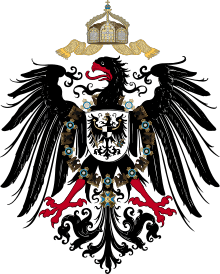Princess Victoria Louise of Prussia
Princess Victoria Louise of Prussia (Viktoria Luise Adelheid Mathilde Charlotte; 13 September 1892 – 11 December 1980) was the only daughter and the last child of German Emperor Wilhelm II and Augusta Victoria of Schleswig-Holstein. She was a great-granddaughter of Queen Victoria through her father. Her 1913 marriage to Prince Ernest Augustus of Hanover was the largest gathering of reigning monarchs in Germany since German unification in 1871, and one of the last great social events of European royalty before the First World War began fourteen months later.
Shortly after the wedding, she became the Duchess of Brunswick by marriage. Through her daughter Frederica, Princess Victoria Louise was the maternal grandmother of Queen Sophia of Spain (mother of Felipe VI, King of Spain) and the former King Constantine II of Greece.
Early life and education
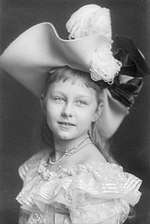
Princess Victoria Louise Adelheid Mathilde Charlotte was born on 13 September 1892, the seventh child and only daughter of German Emperor Wilhelm II and Empress Augusta Victoria. "After six sons, God has given us our seventh child, a small but very strong little daughter," the empress wrote in her diary soon after the birth.[1] The young princess was christened on 22 October,[2] and was named after her paternal great-grandmother, Queen Victoria, and her paternal great great grandmother, Louise of Mecklenburg-Strelitz.[3] Known officially as Victoria Louise, she would be nicknamed "Sissy" by her family.[4]
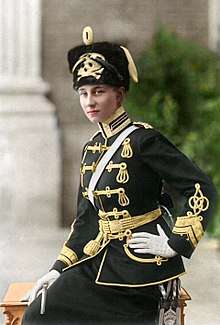
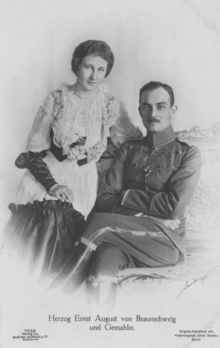
Historian Justin C. Vovk writes that Victoria Louise was intelligent like her paternal grandmother Empress Frederick, stately and dignified like her mother, but imperious and willful like her father. She enjoyed being the center of attention,[5] and was her father's favourite.[6][7] According to her eldest brother Crown Prince Wilhelm, Victoria Louise was "the only one of us who succeeded in her childhood in gaining a snug place" in their father's heart.[8] In 1902, her English governess, Anne Topham, observed in their first meeting that the nine-year-old princess was friendly, energetic, and always quarreling with her next eldest brother, Prince Joachim.[9] Anne later noted that the "warlike" emperor "unbends to a considerable extent when in the bosom of his family," and is the "dominating force of his daughter's life. His ideas, his opinions on men and things are persistently quoted by her."[10]
The family resided at Homburg Castle,[11] and Victoria Louise and Joachim would often visit their cousins – the children of the Prussian princesses Margaret and Sophia – at nearby Kronberg Castle.[12] In 1905, the princess studied music with concert pianist Sandra Drouker. For a period of one week in May 1911, Victoria Louise traveled to England aboard the Hohenzollern with her parents, where they visited their cousin King George V for the unveiling of a statue of Queen Victoria in front of Buckingham Palace.[13] Her confirmation took place at Friedenskirche in Potsdam on 18 October 1909.[14]
Marriage
In 1912, Ernest Augustus, the wealthy heir to the title of Duke of Cumberland, came to the Berlin court to thank Emperor Wilhelm for having Crown Prince Wilhelm and Prince Eitel Friedrich attend the funeral of his brother, Prince George William. While in Berlin, Ernest Augustus met Victoria Louise, and the two became smitten with each other.[8] However, any discussions of marriage were prolonged for months due to political concerns;[15] Ernest Augustus was also the heir to the Kingdom of Hanover, which had been annexed into the Kingdom of Prussia following the 1866 Austro-Prussian War. The Prussian crown prince was displeased with the match and wished that Ernest Augustus abdicate his rights to Hanover; in a compromise, it was decided that in exchange, he would succeed to the smaller duchy of Brunswick, of which his father was the lawful heir. The family had been barred from the succession to Brunswick due to their claims towards the Hanoverian kingdom.[16] They were engaged in Karlsruhe on 11 February 1913.[17]
Their wedding, an extravagant affair, took place on 24 May 1913 in Berlin. It was hailed in the press as the end of the rift between the House of Hanover and House of Hohenzollern that had existed since the 1866 annexation.[18] The Times described the union as akin to Romeo and Juliet, albeit with a happier ending.[19] Despite the press' fixation on the union as a love match, it remains unclear if the match was one of love or politics;[19] historian Eva Giloi believes that the marriage was more likely the result of Prussia's desire to end the rift,[20] though in one of Victoria Louise's letters she described it as a "love match".[19]
In a diplomatic gesture, Emperor Wilhelm invited almost all of his extended family.[21] Also two imprisoned British spies Captain Stewart and Captain Trench, were pardoned and released by the Kaiser as a present to the United Kingdom.[22] The wedding became the largest gathering of reigning monarchs in Germany since German unification in 1871, and one of the last great social events of European royalty before World War I began fourteen months later.[23] Attendees included Wilhelm's cousins King George V and Tsar Nicholas II, accompanied by their respective wives Queen Mary and Tsarina Alexandra.[23] The wedding feast included 1,200 guests.[24] Empress Augusta Victoria took the separation from her only daughter badly and wept.[24]
Children and pregnancies
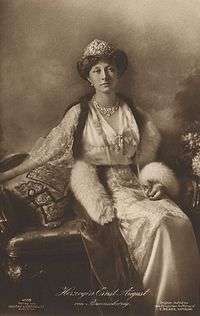
The new duke and duchess of Brunswick moved to the capital of Brunswick and began their family with the birth of their eldest son, Prince Ernest Augustus, less than a year after their wedding.[25] They would have four further children: Prince George William (b. 1915), Princess Frederica (b. 1917), Prince Christian Oscar (b. 1919), and Prince Welf Henry (b. 1923).
On 8 November 1918, her husband was forced to abdicate his throne along with the other German kings, grand dukes, dukes, and princes, and the duchy of Brunswick was subsequently abolished. The next year, he was deprived of his British titles under the Titles Deprivation Act 1917 as a result of his service in the German army during the war, and the younger Ernest Augustus's title as Prince of the United Kingdom was removed under the same Act.[26]
Thus, when his father died in 1923, Ernest Augustus did not succeed to his father's British title of Duke of Cumberland. For the next thirty years, Ernest Augustus would remain as head of the House of Hanover, living in retirement on his various estates.
World War II
World War II saw the rise of the Nazi Germany. Several of Victoria Louise's brothers joined the Nazi party, including former Crown Prince Wilhelm and Prince August Wilhelm.[27] While Ernest Augustus never officially joined the party, he donated funds and was close to several leaders.[28] As a former British prince, Ernest Augustus as well as Victoria Louise desired a rapprochement between England and Germany. Ostensibly desiring to pursue an alliance with the UK, in the mid-1930s, Adolf Hitler took advantage of their sentiment by asking the couple to arrange a match between their daughter Princess Frederica and the Prince of Wales. The Duke and Duchess of Brunswick refused, believing that the age difference was too great.[29]
In May 1941, her father fell ill from an intestinal blockage, and Victoria Louise traveled to Doorn to visit him, as did several of her brothers. Wilhelm recovered enough for them to depart, but soon relapsed. Victoria Louise returned in time to be at her father's bedside, along with nephew Louis Ferdinand and stepmother Hermine, when he died on 4 June 1941 of a pulmonary embolism.[30] By the time of the war's ending in Europe in April 1945, Victoria Louise was living with her husband at Blankenburg Castle.[31] A few days before Blankenburg was handed over to the Red Army by British and US forces in late 1945, to become part of East Germany, the family was able to quickly move to Marienburg Castle (Hanover) with all their furniture, transported by British army trucks, on the order of King George VI.[32]
Later life
After the war, Victoria Louise spent much of her time attending public events in Lower Saxony, supporting palace restoration projects, high-society parties, hunting, and the showing of horses. She also spent time helping with philanthropic causes, for instance supporting a holiday estate for low-income children.[33] When Victoria Louise's eldest son made Marienburg a museum in 1954 and moved himself to Calenberg Estate nearby, she became at odds with him, although he had offered her several other manor houses to move in. There was also a rivalry between them about her popularity and public appearances. Instead, she moved back to Brunswick, occupying a house which had been offered to her by a wealthy industrialist and a circle of fans called „Braunschweiger Freundeskreis“ (circle of Brunswick friends). She lived there until her death. She is buried next to her husband in front of the Royal Mausoleum in the Berggarten at Herrenhausen Gardens in Hanover, which is the burial chapel of Ernest Augustus, King of Hanover, and his wife.[34]
 The princess and her mother in Berlin (1911)
The princess and her mother in Berlin (1911) The Family in the Sanssouci Park, painting by William Friedrich Georg Pape
The Family in the Sanssouci Park, painting by William Friedrich Georg Pape Portrait of the princess of 1913
Portrait of the princess of 1913 The Imperial couple (standing) and their family in 1915, in front of the New Palace
The Imperial couple (standing) and their family in 1915, in front of the New Palace
Publications
Approximate translations of the titles into English are given in parentheses.
- Ein Leben als Tochter des Kaisers ("Life as Daughter of the Emperor")
- Im Strom der Zeit ("In the Stream of Time")
- Bilder der Kaiserzeit ("Pictures from the Imperial Period")
- Vor 100 Jahren ("100 Years Ago")
- Die Kronprinzessin ("The Crown Princess")
- Deutschlands letzte Kaiserin ("Germany's Last Empress")
Legacy
David Jones records in his prose-poem In Parenthesis a fragment of song from the Western Front - "I want Big Willie's luv-ly daughter" - implying (as Jones notes) "that the object of the British Expedition into France was to enjoy the charms of the Emperor's daughter".[35]
Named for the princess:
- SMS Victoria Louise, protected cruiser launched 29 March 1897, scrapped in 1923.
- Prinzessin Victoria Luise, launched 29 June 1900; wrecked off Jamaica, 16 December 1906.
- Viktoria Luise, launched 10 January 1900, as the Deutschland; refitted and renamed Viktoria Luise, 1910; renamed Hansa 1921; sold for scrap, 1925.
- The Zeppelin LZ 11 of the Verkehrsluftschiff der Deutschen Luftschifffahrts Aktiengesellschaft (DELAG) was named Viktoria Luise.
Titles, styles, and honours
Titles and styles
- 13 September 1892 – 24 May 1913: Her Royal Highness Princess Victoria Louise of Prussia
- 24 May – 1 November 1913: Her Royal Highness Princess Ernest Augustus of Hanover
- 1 November 1913 – 30 January 1953: Her Royal Highness The Duchess of Brunswick
- 20 January 1953 – 11 December 1980: Her Royal Highness The Dowager Duchess of Brunswick
As the wife of a prince of the House of Hanover, Viktoria Louise also bore the titles Princess of Hanover, Princess of Great Britain and Ireland and Duchess of Brunswick and Lüneburg.
Honours
.svg.png)
- Dame Grand Cross of the Order of the Black Eagle[36]
- Dame of the Order of Louise[36][37]
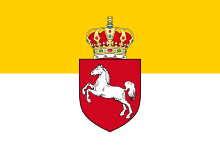
.svg.png)
.svg.png)

Regimental commissions
- Regimentschefin (Regimental Chief) and Oberst à la suite (Honorary Colonel), 2. Leib-Husaren Regiment Königin Victoria von Preußen Nr. 2, ca. 1909[38]
Issue
| Name | Birth | Death | Notes |
|---|---|---|---|
| Prince Ernest Augustus | 18 March 1914 | 9 December 1987 (aged 73) | married firstly 1951, Princess Ortrud of Schleswig-Holstein-Sonderburg-Glücksburg; had issue.
married secondly 1981, Countess Monika of Solms-Laubach; no issue. |
| Prince George William | 25 March 1915 | 8 January 2006 (aged 90) | married 1946, Princess Sophie of Greece and Denmark; had issue. |
| Frederica, Queen of the Hellenes | 18 April 1917 | 6 February 1981 (aged 63) | married 1938, Paul of Greece; had issue. |
| Prince Christian Oscar | 1 September 1919 | 10 December 1981 (aged 62) | married 1963, Mireille Dutry (b. 10 January 1946); divorced 1976; had issue. |
| Prince Welf Henry | 11 March 1923 | 12 July 1997 (aged 74) | married 1960, Princess Alexandra of Ysenburg and Büdingen; no issue. |
Ancestry
| Ancestors of Princess Victoria Louise of Prussia |
|---|
References
- ↑ Vovk 2012, p. 79.
- ↑ Vovk 2012, pp. 79–80.
- ↑ Pakula 1997, p. 558.
- ↑ Vovk 2012, p. 80.
- ↑ Vovk 2012, pp. 242–243.
- ↑ Clay 2007, p. 113.
- ↑ Cecil 1996, p. 10.
- 1 2 Vovk 2012, p. 243.
- ↑ Topham 1915, pp. 11–13.
- ↑ Topham 1915, pp. 12, 18.
- ↑ Viktoria Luise 1977, pp. 18.
- ↑ Topham 1915, p. 14.
- ↑ MacDonogh 2000, p. 323.
- ↑ Viktoria Luise 1977, pp. 40.
- ↑ Vovk 2012, pp. 243–244.
- ↑ MacDonogh 2000, p. 340.
- ↑ Viktoria Luise 1977, pp. 57.
- ↑ Riotte 2011, p. 305.
- 1 2 3 Riotte 2008, p. 95.
- ↑ Giloi 2011, p. 167.
- ↑ Vovk 2012, p. 244.
- ↑ Emmerson 2013, p. 13
- 1 2 Vovk 2012, pp. xxvii–xxviii.
- 1 2 Vovk 2012, p. 246.
- ↑ Vovk 2012, pp. 246–247.
- ↑ "At the Court at Buckingham Palace, the 28th day of March, 1919". London Gazette. His Majesty's Stationery Office. 28 March 1919. pp. Issue 31255, Page 4000. Retrieved 28 November 2011.
Their Lordships do humbly report to Your Majesty that the persons hereinafter named have adhered to Your Majesty's enemies during the present war: —His Royal Highness Leopold Charles, Duke of Albany, Earl of Clarence and Baron Arklow; His Royal Highness Ernest Augustus, Duke of Cumberland and Teviotdale, Earl of Armagh; His Royal Highness Ernest Augustus (Duke of Brunswick), Prince of Great Britain and Ireland; Henry, Viscount Taaffe of Corren and Baron of Ballymote."
- ↑ Petropoulos 2006, p. 167.
- ↑ Petropoulos 2006, p. 99.
- ↑ Petropoulos 2006, pp. 159–62.
- ↑ Cecil 1996, p. 353.
- ↑ MacDonogh 2007, p. 75.
- ↑ Viktoria Luise 1977, pp. 155.
- ↑ Giloi 2011, p. 360.
- ↑ Source (in German): "Herzogin Viktoria Luise" in: Internationales Biographisches Archiv 12/1981 vom 9. März 1981.
- ↑ D. Jones, In Parenthesis (London 1969) p. 104 and p. 213
- 1 2 3 4 5 6 Schench, G. Handbuch über den Königlich Preußischen Hof und Staat fur das Jahr 1908. Berlin, Prussia, 1907.
- ↑ http://www.meaus.com/princess-victoria-luise.htm
- ↑ Schench 1907.
- Works cited
- Black, Jeremy (2004). The Hanoverians: The History of a Dynasty. New York: Hambledon and London. ISBN 1852854464.
- Cecil, Lamar (1996). Wilhelm II: Emperor and Exile, 1900-1941, Volume 2. Chapel Hill, NC: University of North Carolina Press.
- Emmerson, Charles (2013). 1913: The World before the Great War (2013 ed.). Random House. ISBN 9781448137329. - Total pages: 544
- Giloi, Eva (2011). Monarchy, Myth, and Material Culture in Germany 1750-1950. Cambridge, UK: Cambridge University Press. ISBN 978-0-521-76198-7.
- Clay, Catrine (2007). King, Kaiser, Tsar: Three Royal Cousins Who Led the World to War. Walker & Company. ISBN 978-0802716231.
- MacDonogh, Giles (2000). The Last Kaiser: The Life of Wilhelm II. New York: St. Martin's Press. ISBN 0-312-30557-5.
- MacDonogh, Giles (2007). After the Reich: The Brutal History of the Allied Occupation. New York: Basic Books. ISBN 978-0465003389.
- Pakula, Hannah (1997). An Uncommon Woman: The Empress Frederick, Daughter of Queen Victoria, Wife of the Crown Prince of Prussia, Mother of Kaiser Wilhelm. New York: Simon and Schuster Inc. ISBN 0684842165.
- Petropoulos, Jonathan (2006). Royals and the Reich: The Princes von Hessen in Nazi Germany. New York: Oxford University Press. ISBN 0195339274.
- Riotte, Torsten (2008). "The House of Hanover, Queen Victoria and the Gelph dynasty". In Urbach, Karina. Royal Kinship. Anglo-German Family Networks 1815-1918. Munich: K.G. Saur Verlag. ISBN 978-3-598-23003-5.
- Riotte, Torsten (2011). "Hanoverian Exile and Prussian Governance: King George V of Hanover and His Successor in Austria, 1866-1913". In Mansel, Philip; Riotte, Torsten. Monarchy and Exile: The Politics of Legitimacy from Marie de Médicis to Wilhelm II. Basingstoke, Hampshire: Palgrave Macmillan. ISBN 978-0-230-24905-9.
- Schench, G. (1907). Handbuch über den Königlich Preuβischen Hof und Staat fur das Jahr 1908 [Manual of the Royal Prussian Court and State for the year 1908] (in German). Berlin.
- Topham, Anne (1915). Memories of the Kaiser's Court. New York: Dodd, Mead and Company.
- Viktoria Luise, Herzogin zu Braunschweig und Lüneburg (1977). The Kaiser's Daughter: Memoirs of H. R. H. Viktoria Luise, Duchess of Brunswick and Lüneburg, Princess of Prussia. Prentice-Hall. ISBN 978-0-13-514653-8.
- Vovk, Justin C. (2012). Imperial Requiem: Four Royal Women and the Fall of the Age of Empires. Bloomington, IN: iUniverse. ISBN 978-1-4759-1749-9.
External links
| Wikimedia Commons has media related to Princess Viktoria Luise of Prussia. |
Princess Victoria Louise of Prussia Born: 13 September 1892 Died: 11 December 1980 | ||
| Hanoverian royalty | ||
|---|---|---|
| Vacant Title last held by Princess Marie of Badenas Duchess of Brunswick-Wolfenbüttel |
Duchess consort of Brunswick 1 November 1913 – 8 November 1918 |
Vacant |
| Titles in pretence | ||
| Loss of title |
— TITULAR — Duchess consort of Brunswick 8 November 1918 – 30 January 1953 Reason for succession failure: Duchy abolished in 1918 |
Succeeded by Princess Ortrud of Schleswig-Holstein-Sonderburg-Glücksburg |
| Preceded by Princess Thyra of Denmark |
— TITULAR — Queen consort of Hanover 14 November 1923 – 30 January 1953 Reason for succession failure: Hanover annexed by Prussia in 1866 | |
| — TITULAR — Duchess consort of Cumberland and Teviotdale 14 November 1923 – 30 January 1953 Reason for succession failure: Titles Deprivation Act 1917 | ||
.jpg)
